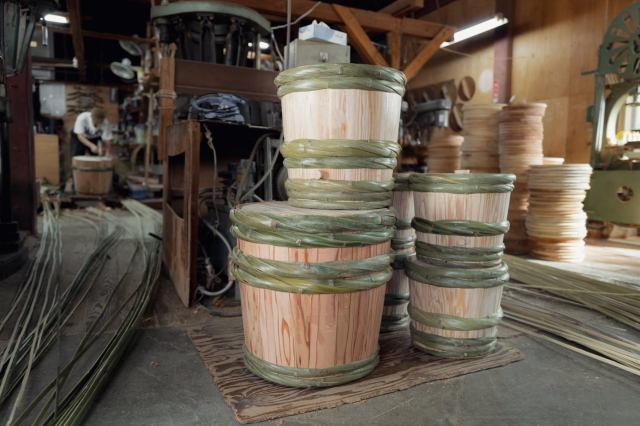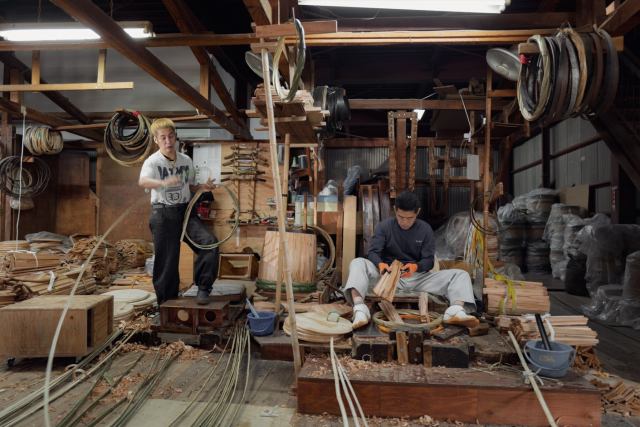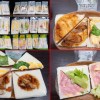
One of Japan’s oldest breweries carries on the craft as UNESCO registers Japanese sake brewing as Intangible Cultural Heritage this month.
The production of Japanese fermented rice alcohol, popularly known as sake in English and more specifically nihonshu in Japanese, has a storied history dating back more than 2,500 years. On December 5 at a UNESCO Intergovernmental Committee in Paraguay, the decision was made to officially register “the traditional knowledge and skills of sake-making with koji mold in Japan” as UNESCO Intangible Cultural Heritage. Many people have said that the move was long overdue since sake has played an integral role in Japanese cultural ceremonies and more for millennia.
Therefore, it was a perfect time for one of Japan’s oldest sake breweries, Kenbishi Shuzo, to also affirm its commitment to the manufacturing of traditional wooden sake barrels as part of its legacy to honor the UNESCO registration.
▼ A master craftsman making a wooden sake barrel by hand
Kenbishi Shuzo is one of Japan’s oldest sake breweries, originally founded in 1505. It’s located in Hyogo Prefecture’s Nada-Gogo, the largest sake-producing area of Japan. Traditional wooden sake barrels wrapped in decorative straw mats, called komodaru, are the third sake brewing-related product that the company is now producing in house following other wooden sake utensils and the straw ropes that are wrapped around the barrels for transportation.
▼ Kenbishi Shuzo’s emblem
With such a long history dating back to the Eisho period (1504-1521), Kenbishi Shuzo has delighted consumers of sake for hundreds of years and even found its way into contemporary art. Take the following Edo-period ukiyo-e woodblock print in Hiroshige Utagawa’s famous Fifty-three Stations of the Tokaido series, for instance, in which a sake barrel with Kenbishi Shuzo’s distinctive emblem is shown being carried by two men in the lower right.
▼ “No. 1 Nihonbashi” (1847-1852) by Hiroshige Utagawa
Kenbishi Shuzo traditionally made its sake barrels using straw and other natural materials to show its deep appreciation to the natural world and for use in ceremonial offerings. However, in 2016, the company’s supplier of straw rope ceased production when its manufacturing machine broke down. Vinyl barrels were then used instead, but something just never felt quite right about that.
When all kinds of sake brewing-related businesses were closing in the aftermath of the pandemic, Kenbishi Shuzo decided to take matters into its own hands–literally. In 2023, the company hired three barrel-making craftsmen from Hyogo Prefecture to start their own production of sake barrels and be able to pass the techniques down to successive generations. This year, these three joined four craftsmen already working for the company’s in-house Wooden Tub Project, begun back in 2009. The end of the year is incredibly busy for sake producers as New Year’s draws near, and thankfully, business is booming as Kenbishi Shuzo is now supplying traditionally made wooden barrels not only for use with its own sake, but also for other sake breweries across Japan.
In light of sake brewing being registered as UNESCO Intangible Cultural Heritage and Kenbishi Shuzo reaffirming its commitment to passing down the traditional craft of barrel-making for generations to come, now is a perfect time to show your own appreciation for the alcoholic beverage. In fact, if you’ll be visiting Osaka over the winter months, you can even get a chance to taste Kenbishi Shuzo’s own Kuromatsu Kenbishi hot sake while riding the Osaka Wheel as part of the city’s special Kotatsu in the Sky campaign. Cheers to thousands of years of sake love!
Source, images: PR Times
● Want to hear about SoraNews24’s latest articles as soon as they’re published? Follow us on Facebook and Twitter!





 What are the ten most popular Japanese sake brands? New poll reveals the favorites of sake lovers
What are the ten most popular Japanese sake brands? New poll reveals the favorites of sake lovers Japan petitions to add 40 traditional folk dances to UNESCO’s Intangible Cultural Heritage list
Japan petitions to add 40 traditional folk dances to UNESCO’s Intangible Cultural Heritage list Century-old Hiroshima brewery in one of Japan’s three great sake-brewing spots offers tours in English
Century-old Hiroshima brewery in one of Japan’s three great sake-brewing spots offers tours in English Airbnb offers special free stay at a traditional Japanese gassho house in a World Heritage Site
Airbnb offers special free stay at a traditional Japanese gassho house in a World Heritage Site Ramen restaurant’s English menu prices are nearly double its Japanese ones, denies discriminating
Ramen restaurant’s English menu prices are nearly double its Japanese ones, denies discriminating Top Japanese cosplayer Enako returns to Comiket after 6 years, creates mayhem with admirers
Top Japanese cosplayer Enako returns to Comiket after 6 years, creates mayhem with admirers Rakuten randomly offers 58 New Year’s osechi feasts in Japan, but did we get a star or a dud?
Rakuten randomly offers 58 New Year’s osechi feasts in Japan, but did we get a star or a dud? What makes a good boss in Japan? Workers sound off in survey
What makes a good boss in Japan? Workers sound off in survey The Purple Lucky Bag from Village Vanguard is an extra-large waste of money
The Purple Lucky Bag from Village Vanguard is an extra-large waste of money 25 different Japanese convenience store sandwiches – What’s inside them?【Photos】
25 different Japanese convenience store sandwiches – What’s inside them?【Photos】 7 great places to see Mt. Fuji from without having to climb it
7 great places to see Mt. Fuji from without having to climb it Japanese convenience store fools us with its 40-percent-more sandwich, but in a good way
Japanese convenience store fools us with its 40-percent-more sandwich, but in a good way We made pan-fried and baked mini apple pies using gyoza dumpling wrappers【SoraKitchen】
We made pan-fried and baked mini apple pies using gyoza dumpling wrappers【SoraKitchen】 Nearly one in ten young adults living in Japan isn’t ethnically Japanese, statistics show
Nearly one in ten young adults living in Japan isn’t ethnically Japanese, statistics show Starbucks Japan ready to get Year of the Horse started with adorable drinkware and plushies【Pics】
Starbucks Japan ready to get Year of the Horse started with adorable drinkware and plushies【Pics】 Japanese beef bowl chain Sukiya’s 2026 Smile Box lucky bag basically pays for itself
Japanese beef bowl chain Sukiya’s 2026 Smile Box lucky bag basically pays for itself Hayao Miyazaki says Happy New Year to Studio Ghibli fans with new art for Year of the Horse
Hayao Miyazaki says Happy New Year to Studio Ghibli fans with new art for Year of the Horse Cup Noodle tries an authentic Jiro-style ramen, but something’s not quite right
Cup Noodle tries an authentic Jiro-style ramen, but something’s not quite right The best Starbucks Japan Frappuccinos we want to drink again in 2026
The best Starbucks Japan Frappuccinos we want to drink again in 2026 We revisited Sweets Paradise after a decade to see if Japan’s dessert buffet still delivers
We revisited Sweets Paradise after a decade to see if Japan’s dessert buffet still delivers That time Seiji called JASRAC to ask why he didn’t get paid royalties for his song being on TV
That time Seiji called JASRAC to ask why he didn’t get paid royalties for his song being on TV We found possibly the quietest Japanese-style hotel in Tokyo’s bustling Shinjuku district
We found possibly the quietest Japanese-style hotel in Tokyo’s bustling Shinjuku district Pizza Hut Japan’s hot lucky bags are perfect for a New Year’s pizza party
Pizza Hut Japan’s hot lucky bags are perfect for a New Year’s pizza party Japan’s oldest largetooth sawfish in captivity back on display in Mie Prefecture
Japan’s oldest largetooth sawfish in captivity back on display in Mie Prefecture 7-Eleven Japan starts new temporary luggage storage service in over 300 branches
7-Eleven Japan starts new temporary luggage storage service in over 300 branches Disillusionment at Tsukiji’s tourist-target prices led us to a great ramen restaurant in Tokyo
Disillusionment at Tsukiji’s tourist-target prices led us to a great ramen restaurant in Tokyo Starbucks teams up with 166-year-old Kyoto doll maker for Year of the Horse decorations【Photos】
Starbucks teams up with 166-year-old Kyoto doll maker for Year of the Horse decorations【Photos】 Tokyo considering law requiring more trash cans following litter increase in heavily touristed area
Tokyo considering law requiring more trash cans following litter increase in heavily touristed area Tokyo’s Tsukiji sushi neighborhood asks tour groups to stay away for the rest of the month
Tokyo’s Tsukiji sushi neighborhood asks tour groups to stay away for the rest of the month Tokyo event lets you travel back in time, for free, to celebrate 100 years since Showa era start
Tokyo event lets you travel back in time, for free, to celebrate 100 years since Showa era start Japan may add Japanese language proficiency, lifestyle classes to permanent foreign resident requirements
Japan may add Japanese language proficiency, lifestyle classes to permanent foreign resident requirements Sanrio theme park in Japan announces plans to expand into a Sanrio resort
Sanrio theme park in Japan announces plans to expand into a Sanrio resort Stamina-destroying “Paralysis Noodles” are Tokyo’s newest over-the-top ramen innovation
Stamina-destroying “Paralysis Noodles” are Tokyo’s newest over-the-top ramen innovation Survey asks foreign tourists what bothered them in Japan, more than half gave same answer
Survey asks foreign tourists what bothered them in Japan, more than half gave same answer Japan’s human washing machines will go on sale to general public, demos to be held in Tokyo
Japan’s human washing machines will go on sale to general public, demos to be held in Tokyo Japan’s deadliest food claims more victims, but why do people keep eating it for New Year’s?
Japan’s deadliest food claims more victims, but why do people keep eating it for New Year’s? We deeply regret going into this tunnel on our walk in the mountains of Japan
We deeply regret going into this tunnel on our walk in the mountains of Japan Studio Ghibli releases Kodama forest spirits from Princess Mononoke to light up your home
Studio Ghibli releases Kodama forest spirits from Princess Mononoke to light up your home Major Japanese hotel chain says reservations via overseas booking sites may not be valid
Major Japanese hotel chain says reservations via overseas booking sites may not be valid Put sesame oil in your coffee? Japanese maker says it’s the best way to start your day【Taste test】
Put sesame oil in your coffee? Japanese maker says it’s the best way to start your day【Taste test】 No more using real katana for tourism activities, Japan’s National Police Agency says
No more using real katana for tourism activities, Japan’s National Police Agency says Starbucks Japan reveals new sakura drinkware collection, inspired by evening cherry blossoms
Starbucks Japan reveals new sakura drinkware collection, inspired by evening cherry blossoms Updated cherry blossom forecast shows extra-long sakura season for Japan this year
Updated cherry blossom forecast shows extra-long sakura season for Japan this year
Leave a Reply